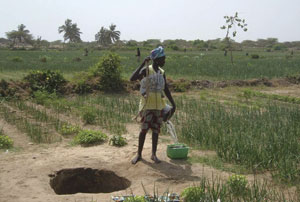Knowledge fuels change - Support energypedia!
For over 10 years, energypedia has been connecting energy experts around the world — helping them share knowledge, learn from each other, and accelerate the global energy transition.
Today, we ask for your support to keep this platform free and accessible to all.
Even a small contribution makes a big difference! If just 10–20% of our 60,000+ monthly visitors donated the equivalent of a cup of coffee — €5 — Energypedia would be fully funded for a whole year.
Is the knowledge you’ve gained through Energypedia this year worth €5 or more?
Your donation keeps the platform running, helps us create new knowledge products, and contributes directly to achieving SDG 7.
Thank you for your support, your donation, big or small, truly matters!
Difference between revisions of "Micro-Solar Utilities for Small-Scale Irrigation"
***** (***** | *****) |
***** (***** | *****) |
||
| Line 1: | Line 1: | ||
| + | |||
| Line 11: | Line 12: | ||
| style="width: 324px;" | Micro-Solar Utilities for Small-Scale Irrigation in Senegal | | style="width: 324px;" | Micro-Solar Utilities for Small-Scale Irrigation in Senegal | ||
|- | |- | ||
| − | | style="width: 146px;" | | + | | style="width: 146px;" | Collaborators |
| style="width: 324px;" | The MDG Center West and Central Africa (Senegal) | | style="width: 324px;" | The MDG Center West and Central Africa (Senegal) | ||
|- | |- | ||
| Line 23: | Line 24: | ||
[[File:Earth Institute.png|frame|right|200px|Working with traditional bucket © www.poweringag.org]]In [[Senegal Energy Situation|Senegal]], farmers currently use two practices for watering crops<ref name="Powering Agriculture: http://poweringag.org/2013-winners/earth-institute">Powering Agriculture: http://poweringag.org/2013-winners/earth-institute</ref>:<br/> | [[File:Earth Institute.png|frame|right|200px|Working with traditional bucket © www.poweringag.org]]In [[Senegal Energy Situation|Senegal]], farmers currently use two practices for watering crops<ref name="Powering Agriculture: http://poweringag.org/2013-winners/earth-institute">Powering Agriculture: http://poweringag.org/2013-winners/earth-institute</ref>:<br/> | ||
| + | |||
| + | <br/> | ||
Revision as of 14:13, 18 December 2014
Overview
| Project | Micro-Solar Utilities for Small-Scale Irrigation in Senegal |
| Collaborators | The MDG Center West and Central Africa (Senegal) |
| Location Applied | Potou, Senegal |
| Website | www.earth.columbia.edu |
In Senegal, farmers currently use two practices for watering crops[1]:
- The labor intensive method of flood irrigation with wells and buckets.
- The cost- and energy-intensive method of using-powered motor pumps.
Neither of these options is ideal in a country with immense solar resources that can be harnessed and used to transform practices in the country and region.[1]
Clean Energy Solution
Earth Institute’s solution will enable a small group of farmers to use a central solar energy unit to power multiple AC pumps for irrigation. The proposed solution takes advantage of the benefits of solar without the high costs associated with DC-powered pumps and battery storage. This power will be accessed by farmers with prepaid electricity cards issued by a micro-utility, and sold through local vendors who will benefit from a small commission. Recognizing that a major obstacle to technology adoption is financing, a tariff-based financing model will allow customers to cover their appliance loans in small payments added into their micro-utility bills.[1]
Impact
This innovation will reduce the price of energy for irrigation significantly while reducing the carbon intensity of irrigation and the labor expended on it. These benefits are particularly powerful when looking at the demographics of Senegal’s agricultural workforce, which is more than 85% women.[1]
Organization
The Earth Institute at Columbia University harnesses scientific research, education, and practical solutions to create a more sustainable world through innovation and critical thinking. Earth Institute has partnered with The MDG Center West and Central Africa (WCA) - an organization established to assist WCA countries develop and implement operational strategies aimed at achieving the Millennium Development Goals.[2]
Further Information
- Energy Situation Senegal Energy Situation
- Further Articles on at Energypedia, but also at Agriwaterpedia
- Entry in the PoweringAg Technology Database
- Further Articles on Renewable Energy Finance
- Powering Agriculture Homepage, Earth Institute
- Homepage Earth Institute
Reference
- ↑ 1.0 1.1 1.2 1.3 Powering Agriculture: http://poweringag.org/2013-winners/earth-institute
- ↑ The Earth Institute: http://www.earth.columbia.edu/sections/view/9




















